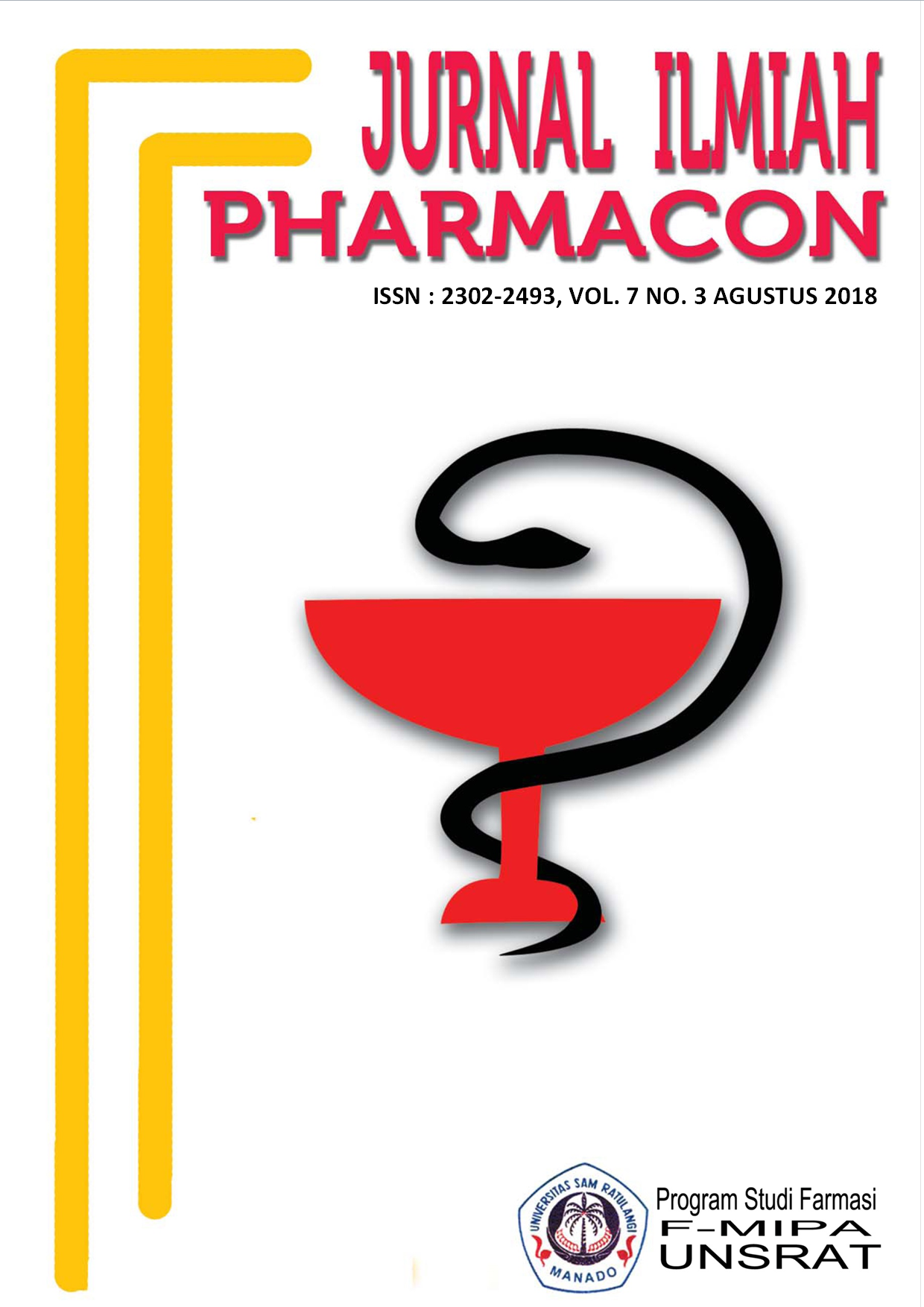PENGARUH VARIASI BABIS KARBOPOL DAN HPMC PADA FORMULASI GEL EKSTRAK ETANOL DAUN TAPAK KUDA (Ipomoea pes-caprae (L.) R. Br. DAN UJI AKTIVITAS ANTIBAKTERI TERHADAP Staphylococcus aureus
DOI:
https://doi.org/10.35799/pha.7.2018.20452Abstract
PENGARUH VARIASI BABIS KARBOPOL DAN HPMC PADA
FORMULASI GEL EKSTRAK ETANOL DAUN TAPAK KUDA
(Ipomoea pes-caprae (L.) R. Br. DAN UJI AKTIVITAS
ANTIBAKTERI TERHADAP Staphylococcus aureus
Veronika Saraung1), Paulina V. Yamlean1), Gayatri Citraningtyas2)
1)Program Studi Farmasi FMIPA UNSRAT Manado, 95115
ABSTRACT
Morning glories leaves contain alkaloids, flavonoids, tannins, steroids, saponins, terpenoids and antroquinones. In vitro, leaf extracts of morning glories has antibacterial activity against gram-positive bacteria that is Staphylococcus aureus. The aim of this research is to make the formulation of gel preparation of ethanol extract of morning glories leaves with two variations of carbopoly concentration of 0.5 % and 2 % and HPMC concentration of 1 %, and 3 %. The method used in this research is laboratory experimental. Physical properties test include organoleptic test, homogeneity, adhesion, spreading and pH. The antibacterial activity test was performed using the well method. The data obtained were analyzed by one-way anova test with 95 % confidence level. The result of this study showed that the ethanol extract gel of morning glories leaves satisfied the parameters of organoleptic gel quality, homogeneity, adhesion, dispersion and pH. Formulation of gel preparation of morning glories leaf ethanol extract with 0.5 % Carbopol base concentration is the best formulation in inhibiting the antibacterial activity of Staphylococcus aureus with 9.5 inhibition zone which included in the category of medium inhibitory zone.
Keywords : Morning glories leaf, gel, Carbopol, HPMC, Staphylococcus aureus.
ABSTRAK
Daun Tapak kuda mengandung alkaloid, flavonoid, tanin, steroid, saponin, terpenoid dan antroquinon. Secara in vitro ekstrak daun Tapak kuda memiliki aktivitas antibakteri terhadap bakteri gram positif yaitu Staphylococcus aureus. Penelitian ini bertujuan untuk membuat formulasi sediaan gel ekstrak etanol daun Tapak kuda dengan dua variasi basis konsentrasi karbopol 0,5 %, 2 % dan konsetrasi HPMC 1 %, 3 %. Metode yang digunakan dalam penelitian ini adalah eksperimental laboratorium. Uji sifat fisik meliputi uji organoleptik, homogenitas,daya lekat,daya sebar dan pH. Uji aktivitas antibakteri dilakukan dengan menggunakan metode sumuran. Data yang diperoleh dianalisa dengan dengan uji one way anova dengan taraf kepercayaan 95 %. Hasil penelitian ini menunjukan bahwa gel ekstrak etanol daun Tapak kuda memenuhi parameter kualitas gel secara organoleptik, homogenitas, daya lekat, daya sebar dan pH. Formulasi sediaan gel ekstrak etanol daun Tapak kuda dengan konsentrasi basis Karbopol 0,5% merupakan formulasi yang paling baik dalam menghambat aktivitas antibakteri Staphylococcus aureus dengan zona hambat 9,5 mm termasuk dalam kategori zona hambat sedang.
Kata kunci: Daun Tapak kuda, gel, Karbopol, HPMC, Staphylococcus aureus
Â
Downloads
Published
How to Cite
Issue
Section
License
Authors who publish with this journal agree to the following terms:
- Authors retain copyright and grant the journal right of first publication with the work simultaneously licensed under a Creative Commons Attribution-NonCommercial 4.0 International License that allows others to share the work with an acknowledgement of the work's authorship and initial publication in this journal.
- Authors are permitted and encouraged to post their work online (e.g., in institutional repositories or on their website) prior to and during the submission process, as it can lead to productive exchanges, as well as earlier and greater citation of published work (See The Effect of Open Access)










